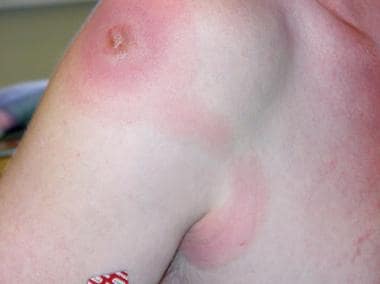Practice Essentials
Lymphangitis is defined as an inflammation of the lymphatic channels that occurs as a result of infection at a site distal to the channel. (See Etiology.)
The lymphatic system encompasses a network of vessels, glands, and organs located throughout the body. Functioning as part of the immune system, it also transports fluids, fats, proteins, and other substances in the body. Lymph nodes, or glands, filter the lymph fluid. Foreign bodies such as bacteria and viruses are processed in the lymph nodes to generate an immune response to fight infection.
However, when pathogenic organisms enter the lymphatic channels, invading directly through an abrasion or wound or as a complication of infection, local inflammation and subsequent infection ensue, manifesting as red streaks on the skin. The inflammation or infection then extends proximally toward regional lymph nodes. Bacteria can grow rapidly in the lymphatic system (see the image below). (See Etiology and Prognosis.)
Although no specific data regarding sex-related demographics are available for lymphangitis, two thirds of patients with cellulitis (a complication of lymphangitis occurring in the absence of appropriate antimicrobial therapy) are reported to be male. (See Presentation and Workup.)
Nodular lymphangitis is a distinct clinical entity, separate from lymphangitis. This disorder is characterized by inflammatory nodules along the lymphatics draining a primary skin infection. (See Etiology and Treatment.)
Etiology
In individuals with normal host defenses, species of group A beta-hemolytic streptococci (GABHS) are the most common causes of lymphangitis. These organisms elaborate fibrinolysins and hyaluronidase, which aid their invasion of lymphatic channels. Lymphangitis caused by GABHS can rapidly progress and has been associated with serious complications.
Staphylococcus aureus can also cause lymphangitis, although the disorder is more likely to occur in patients with cellulitis due to GABHS than in those with cellulitis resulting from S aureus.
Other organisms that can cause lymphangitis include the following:
-
Pseudomonas species
-
Streptococcus pneumoniae - A relatively uncommon cause of lymphangitis
-
Pasteurella multocida - Associated with dog and cat bites; can cause cellulitis and lymphangitis
-
Gram-negative rods, gram-negative bacilli, and fungi - May cause cellulitis and resultant lymphangitis in immunocompromised hosts
-
Aeromonas hydrophila - Can contaminate wounds that occur in freshwater
In addition, individuals with diabetes, immunodeficiency, varicella, chronic steroid use, or other systemic illnesses have increased risk of developing serious or rapidly spreading lymphangitis.
A literature review by Cohen et al indicated that nonbacterial etiologies of lymphangitis with lymphangitic streaking include viral and fungal infections, insect and spider bites, and noninfectious, iatrogenic causes, with the latter reportedly including treatment with bacillus Calmette-Guérin vaccine, purified protein derivative placement, and topical treatment of verrucae vulgaris with cantharidin. [3] Lieberman et al reported a case of viral lymphangitis associated with palmar herpetic whitlow in a child. [4]
Nodular lymphangitis
Nodular lymphangitis commonly follows superficial inoculation with one of the following organisms:
-
Sporothrix schenckii
-
Nocardia brasiliensis
-
Mycobacterium marinum
-
Leishmania panamensis
-
L guyanensis
-
Francisella tularensis
Trepanowski et al described a rare case of nodular lymphangitis caused by methicillin-resistant Staphylococcus aureus. [5]
Prognosis
The prognosis for patients with uncomplicated lymphangitis is good. Antimicrobial regimens are effective in more than 90% of cases. Without appropriate antimicrobial therapy, however, cellulitis may develop or extend along the channels; necrosis and ulceration may occur.
Morbidity and mortality
Lymphangitis may spread within hours. The morbidity and mortality associated with the disease is related to the underlying infection. Although no specific data are available regarding complications and mortality associated with lymphangitis alone, lymphangitis caused by GABHS can lead to bacteremia, sepsis, and death.
-
Trypanosomal chancre on shoulder with lymphangitis toward axilla.








